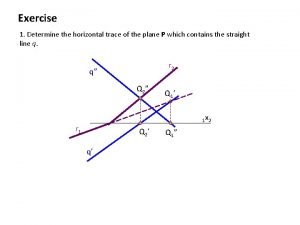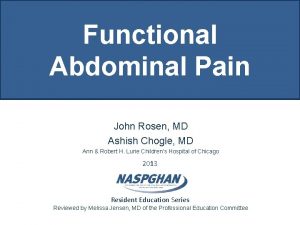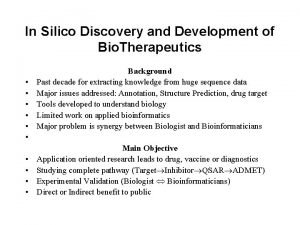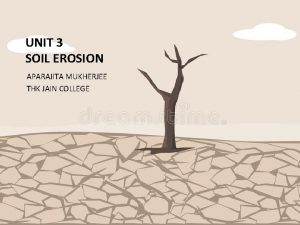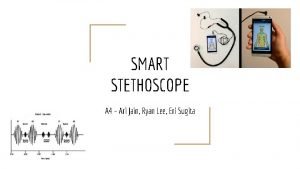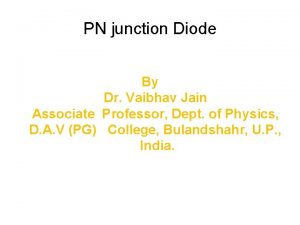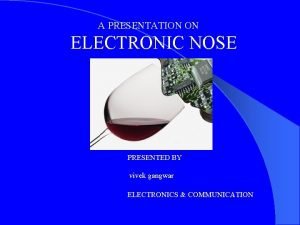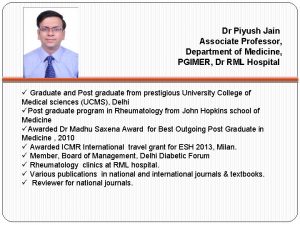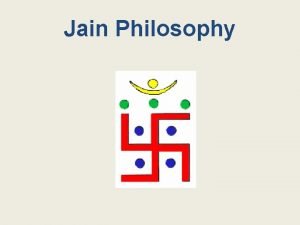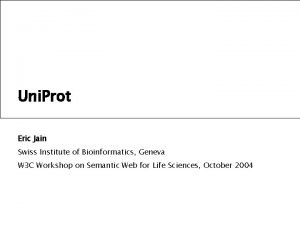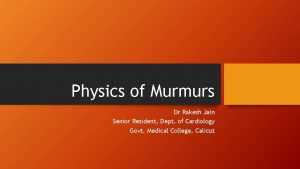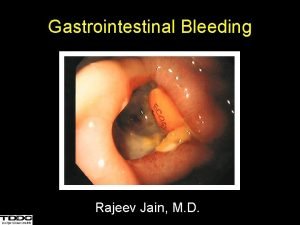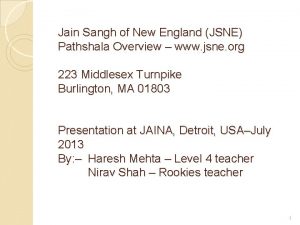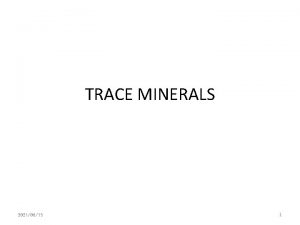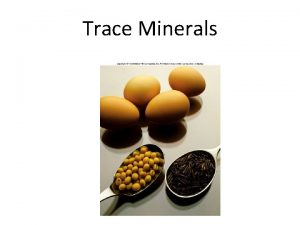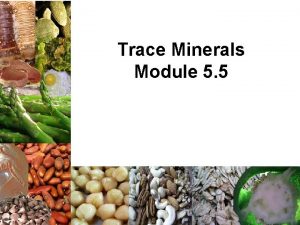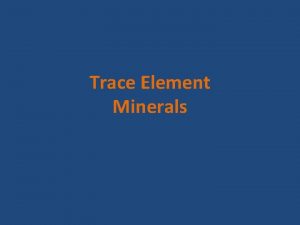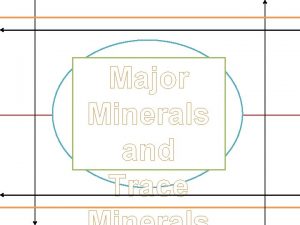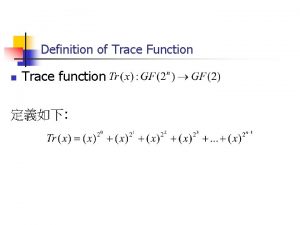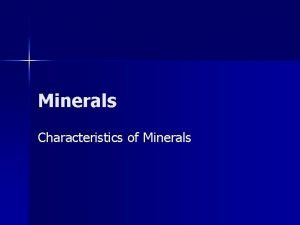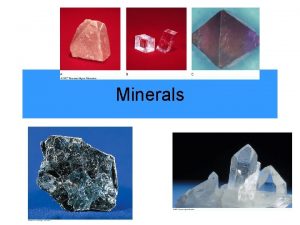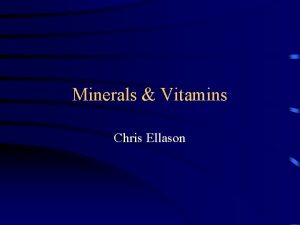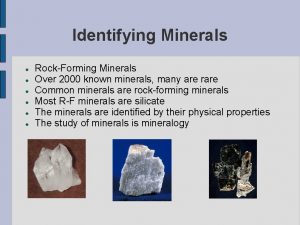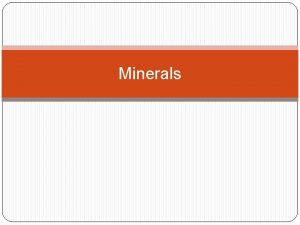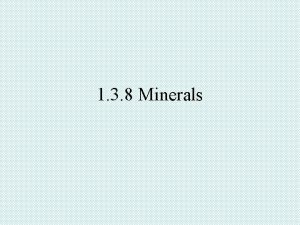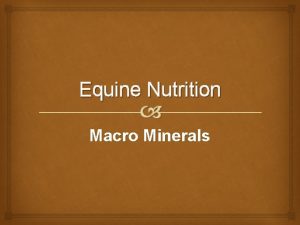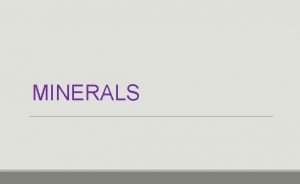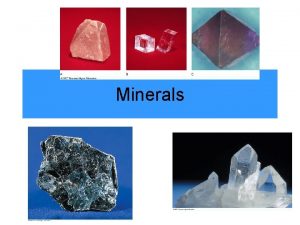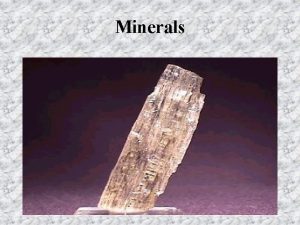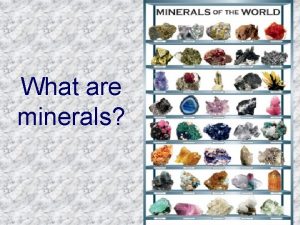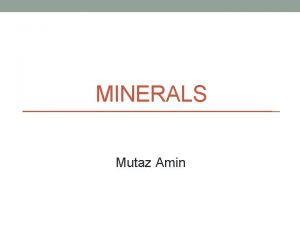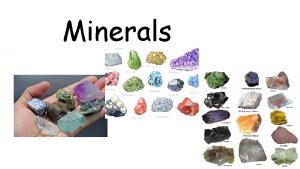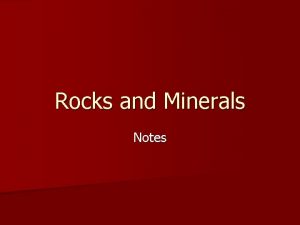The Trace Minerals Dr Ashish Jain Sr Consultant















































- Slides: 47

The Trace Minerals Dr. Ashish Jain Sr. Consultant Critical Care FEHA

The Trace Minerals

The Trace Minerals • Food sources • Deficiencies • Toxicities • Interactions

Iron • Ferrous (Fe++) – Reduced • Ferric (Fe+++) – Oxidized

Iron Absorption

Iron: Heme vs. Nonheme

Iron • Factors enhance nonheme iron absorption – Vitamin C – Citric acid from foods

Iron • Factors enhance nonheme iron absorption – Lactic acid from foods – HCl from stomach – Sugars

Iron • Factors inhibit nonheme iron absorption – Phytates – Fibers – Oxalates

Iron • Factors inhibit nonheme iron absorption – Calcium – Phosphorus – EDTA – Tannic acid

Iron Recycling

Iron • High risk for iron deficiency – Women in their reproductive years – pregnant women – Infants and young children – Teenagers

Iron • Stages of iron deficiency – Iron stores diminish – Transport iron decreases – Hemoglobin production declines

• Both size and color are normal in these blood cells • Blood cells in iron-deficiency anemia are small and pale because they contain less hemoglobin

Iron • Contamination iron • Iron supplements Copyright 2005 Wadsworth Group, a division of Thomson Learning

Iron: In Summary • 2001 RDA – Men: 8 mg/day – Women (19 -50 years): 18 mg/day – Women (51+ years): 8 mg/day • Upper level for adults: 45 mg/day Copyright 2005 Wadsworth Group, a division of Thomson Learning

Iron: In Summary • Chief functions in the body – Part of the protein hemoglobin, which carries oxygen in the blood – Part of the protein myoglobin in muscles, which makes oxygen available for muscle contraction – Necessary for the utilization of energy as part of the cells’ metabolic machinery Copyright 2005 Wadsworth Group, a division of Thomson Learning

Iron: In Summary • Significant sources – Red meats, fish, poultry, shellfish, eggs – Legumes, dried fruits Copyright 2005 Wadsworth Group, a division of Thomson Learning

Iron: In Summary • Deficiency symptoms – Anemia: weakness, fatigue, headaches – Impaired work performance and cognitive function – Impaired immunity – Pale skin, nailbeds, mucous membranes, and palm creases – Concave nails – Inability to regulate body temperature – Pica Copyright 2005 Wadsworth Group, a division of Thomson Learning

Iron: In Summary • Toxicity symptoms – GI distress – Iron overload: infections, fatigue, joint pain, skin pigmentation, organ damage Copyright 2005 Wadsworth Group, a division of Thomson Learning


Zinc • Roles – Metalloenzymes • Absorption – Metallothionein Copyright 2005 Wadsworth Group, a division of Thomson Learning

Zinc • Enteropancreatic circulation Copyright 2005 Wadsworth Group, a division of Thomson Learning

Zinc • Zinc supplementation Copyright 2005 Wadsworth Group, a division of Thomson Learning

Zinc: In Summary • 2001 RDA – Men: 11 mg/day – Women: 8 mg/day • Upper level for adults: 40 mg/day Copyright 2005 Wadsworth Group, a division of Thomson Learning

Zinc: In Summary Chief functions in the body – Part of many enzymes – Associated with the hormone insulin – Involved in making genetic material and proteins, immune reactions, transport of vitamin A, taste perception, wound healing, the making of sperm, and the normal development of the fetus Copyright 2005 Wadsworth Group, a division of Thomson Learning

Zinc • Significant sources – Proteincontaining foods – Red meats, shellfish – Whole grains Copyright 2005 Wadsworth Group, a division of Thomson Learning

Zinc • Deficiency symptoms – Growth retardation, delayed sexual maturation, impaired immune function, hair loss, eye and skin lesions, loss of appetite Copyright 2005 Wadsworth Group, a division of Thomson Learning

Zinc: In Summary • Toxicity symptoms – Loss of appetite, impaired immunity, low HDL, copper and iron deficiencies Copyright 2005 Wadsworth Group, a division of Thomson Learning


Iodine • Iodine vs. iodide • Deficiency – Goitrogens Copyright 2005 Wadsworth Group, a division of Thomson Learning

Iodine: In Summary • 2001 RDA for adults: 150 g/day • Upper level: 1100 g/day • Chief functions in the body – A component of two thyroid hormones that help to regulate growth, development, and metabolic rate Copyright 2005 Wadsworth Group, a division of Thomson Learning

Iodine: In Summary • Significant sources – Iodized salt, seafood, bread, dairy products, plants grown in iodine-rich soil and animals fed those plants • Deficiency disease – Simple goiter – Cretinism Copyright 2005 Wadsworth Group, a division of Thomson Learning

Iodine: In Summary • Deficiency symptoms – Underactive thyroid gland, goiter – Mental and physical retardation in infants (cretinism) • Toxicity symptoms – Underactive thyroid gland, elevated TSH, goiter Copyright 2005 Wadsworth Group, a division of Thomson Learning

Selenium • 2000 RDA for adults: 55 g/day • Upper level for adults: 400 g/day • Chief functions in the body – Defends against oxidation – Regulates thyroid hormone • Significant sources – Seafood, meat – Whole grains, vegetables (depending on soil content) Copyright 2005 Wadsworth Group, a division of Thomson Learning

Selenium • Deficiency symptoms – Predisposition to heart disease characterized by cardiac tissue becoming fibrous (Keshan disease) • Toxicity symptoms – Loss and brittleness of hair and nails – Skin rash, fatigue, irritability, and nervous system disorders – Garlic breath odor Copyright 2005 Wadsworth Group, a division of Thomson Learning

Copper • 2001 RDA for adults: 900 g/day • Upper level for adults: 10, 000 g/day (10 mg/day) • Chief functions in the body – Necessary for absorption and use of iron in the formation of hemoglobin – Part of several enzymes Copyright 2005 Wadsworth Group, a division of Thomson Learning

Copper • Significant sources – Seafood – Nuts, whole grains, seeds, legumes • Deficiency symptoms – Anemia, bone abnormalities • Toxicity symptoms – Liver damage Copyright 2005 Wadsworth Group, a division of Thomson Learning

Manganese • 2001 AI – Men: 2. 3 mg/day – Women: 1. 8 mg/day • Upper level for adults: 11 mg/day • Chief functions in the body – Cofactor for several enzymes Copyright 2005 Wadsworth Group, a division of Thomson Learning

Manganese • Significant sources – Nuts, whole grains, leafy vegetables, tea • Deficiency symptoms – Rare • Toxicity symptoms – Nervous system disorders Copyright 2005 Wadsworth Group, a division of Thomson Learning

Fluoride • 1997 AI – Men: 3. 8 mg/day – Women: 3. 1 mg/day • Upper level for adults: 10 mg/day • Chief functions in the body – Involved in the formation of bones and teeth – Helps to make teeth resistant to decay Copyright 2005 Wadsworth Group, a division of Thomson Learning

U. S. Population With Fluoridated Water Copyright 2005 Wadsworth Group, a division of Thomson Learning

Fluoride • Significant sources – Drinking water (if fluoride containing or fluoridated) – Tea, seafood • Deficiency symptoms – Susceptibility to tooth decay • Toxicity symptoms – Fluorosis (pitting and discoloration of teeth) Copyright 2005 Wadsworth Group, a division of Thomson Learning

Chromium • 2001 AI – Men: 35 g/day – Women: 25 g/day • Chief functions in the body – Enhances insulin action • Significant sources – Meats (especially liver) – Whole grains, brewer’s yeast Copyright 2005 Wadsworth Group, a division of Thomson Learning

Chromium • Deficiency symptoms – Diabetes-like condition • Toxicity symptoms – None reported Copyright 2005 Wadsworth Group, a division of Thomson Learning

Molybdenum • 2001 AI for adults: 45 g/day • Upper level for adults: 2 mg/day • Chief functions in the body – Cofactor for several enzymes • Significant sources – Legumes, cereals – Organ meats Copyright 2005 Wadsworth Group, a division of Thomson Learning

Thanks
 Ashish jain microsoft
Ashish jain microsoft Horizontal trace and vertical trace
Horizontal trace and vertical trace Ashish kaila
Ashish kaila Ashish bajaj fms
Ashish bajaj fms Naveen jonathan
Naveen jonathan Ashish chogle
Ashish chogle Dr ashish kumar bhutani
Dr ashish kumar bhutani Ashish ganguly imtech
Ashish ganguly imtech Ashish goel stanford
Ashish goel stanford Ashish motivala
Ashish motivala Ashish vaswani
Ashish vaswani Ashish kachru
Ashish kachru Ashish singh parihar
Ashish singh parihar Ashish tilethe
Ashish tilethe Raina jain dartmouth
Raina jain dartmouth Dr salil jain
Dr salil jain Jain cosmology
Jain cosmology Reti di calcolatori corradi
Reti di calcolatori corradi 1 yojan in jainism
1 yojan in jainism Jain
Jain Types of oxygen masks and flow rates
Types of oxygen masks and flow rates Jain bcn
Jain bcn Jain society of toronto
Jain society of toronto Aagam jain nlsiu
Aagam jain nlsiu Aparajita jain
Aparajita jain Gfgxx
Gfgxx Earpiece
Earpiece Mitthu jain
Mitthu jain Vinit jain cisco
Vinit jain cisco Eakta jain
Eakta jain Jain center of northern california
Jain center of northern california Vaibhav jain
Vaibhav jain Agam sutras
Agam sutras Vivek jain
Vivek jain Pramod jain lunawat
Pramod jain lunawat Dr piyush jain rml hospital
Dr piyush jain rml hospital Jain
Jain Jainendra k. jain
Jainendra k. jain Cherry hill jain sangh
Cherry hill jain sangh Pankaj jain kanpur
Pankaj jain kanpur Eric jain
Eric jain Prateek jain
Prateek jain Dr tulika jain
Dr tulika jain What is jainism
What is jainism Preet jain
Preet jain Rajeev jain md
Rajeev jain md Conclusion of jainism
Conclusion of jainism Jain sangh of new england
Jain sangh of new england

